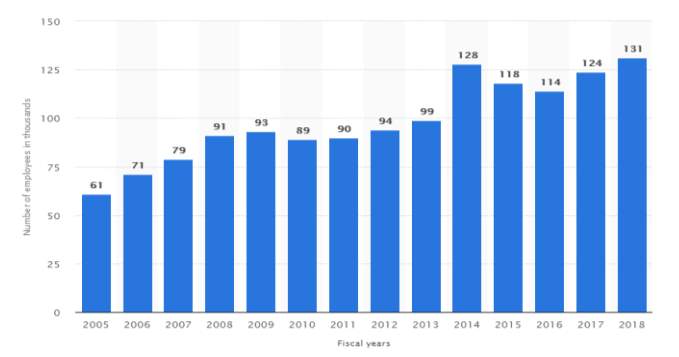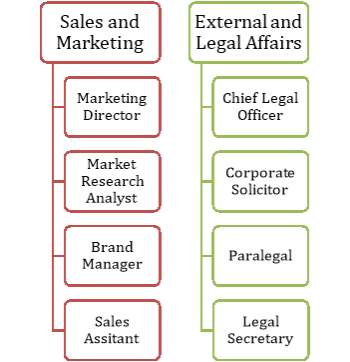Information and Administration
A report on Microsoft, office functions, and workplace legislation
Table of Contents
Give a brief overview of the key aims and objectives of three pieces of workplace legislation.
With the ever-growing developments and contributions offered to the computer technology industry, it is hard to imagine a time before the existence of Microsoft. It is for this reason that the author has chosen Microsoft as a company that he/she is familiar with or would like to work for. The author will provide a brief history of Microsoft and also describe four departments in the organisation and two of the main functions of each of these departments, along with an organisational chart showing four types of personnel included in the departments mentioned in this report.
The author will also describe the administration functions of an office, and will illustrate the importance of these functions constantly being maintained by providing examples of how they may be applied in an everyday office environment, along with three pieces of equipment used to carry out these functions.
Finally, the author will provide a brief overview of three pieces of workplace legislation, briefly outlining the terms of the legislation, along with the key aims and objectives of these pieces of legislation.
In this assignment, information was gathered from secondary sources. These included:
In this report, the author has been tasked with the following:
a. A brief history of the organisation including the type of organisation, its legal form, its size, location and the services and/or provided. They should include company literature which will help illustrate the information they are providing in the report.
b. A description of four different departments in the organisation and at least two of the main functions/activities of each department.
c. An organisation chart showing at least four types of personnel included in the different departments described about (point 2). You should also provide an outline of the typical duties for two of the jobs selected.
A Brief History of Microsoft
The multinational computer technology conglomerate appreciated and trusted by billions worldwide was founded on April 4 1975 by childhood friends, Bill Gates and Paul Allen, in Albuquerque, New Mexico. Today, their Headquarters is located in Redmond, Washington, United States.
In 1981, Microsoft restructured and became an incorporated business, acquiring the new name of Microsoft, Inc.
Microsoft is a privately-owned corporation, in the sense that it is owned by a number of individual shareholders. In 1981, Microsoft became an incorporated business, acquiring the new name of Microsoft, Inc., with Bill Gates as President and Chairman of the Board, and Paul Allen as Executive Vice President. Where the company’s legal form is concerned, Microsoft became a Public Limited Company (PLC) in 1986, following their initial public offering (IPO) which raised $61 million, making approximately 3 billionaires and 10,000 millionaires.

Microsoft is the world’s seventh-largest information technology company by revenue, and in the fiscal year, 2018, they employed 121,000 people globally. This is a marked increase from 61,000 in 2005, as can be seen in the chart below:

Bill Gates and Paul Allen were among the first technology enthusiasts who realised that “the future of personal computing lay in the unlimited potential of software”. (www.thocp.net, 2018)
By 1993, nearly 90% of the world’s PCs ran on a Microsoft operating system!
 It was for this reason that, in 1975, Microsoft developed their version of the programming language BASIC for use on personal computers. This was the first significant achievement for Microsoft and the release of this initial product also saw the acquisition of their first customer, MITS (Micro Instrumentation and Telemetry Systems), who used Microsoft BASIC as the programming language for their product, the Altair 8800 personal computer.
It was for this reason that, in 1975, Microsoft developed their version of the programming language BASIC for use on personal computers. This was the first significant achievement for Microsoft and the release of this initial product also saw the acquisition of their first customer, MITS (Micro Instrumentation and Telemetry Systems), who used Microsoft BASIC as the programming language for their product, the Altair 8800 personal computer.
In 1980, MS-DOS (Microsoft Disk Operating System) was used as an operating system in the IBM PC. This opportunity was a breakthrough for Microsoft as from then on, MS-DOS was a popular choice of operating system for manufacturers of personal computers.
1985, Ireland became home to the first Microsoft international production facility, and in this same year, Microsoft released its first retail version of Microsoft Windows (Windows 1.0).
Apple and Microsoft were once business partners – with Microsoft providing an operating system and other software for the Macintosh, and Bill Gates stating in a 1984 Apple Event that “during 1984, Microsoft expects to get half of its revenues from Macintosh software.” (www.youtube.com, 2018)
 The release of Windows 1.0 soured the relationship between the two technology companies, with the founder of Apple, Steve Jobs, accusing Bill Gates of stealing the idea of the graphical user interface (GUI) from Apple.
The release of Windows 1.0 soured the relationship between the two technology companies, with the founder of Apple, Steve Jobs, accusing Bill Gates of stealing the idea of the graphical user interface (GUI) from Apple.
From this time on, their success skyrocketed. “From 1986 to 1996, Microsoft’s stock soared more than a hundredfold as the company’s Windows operating system and Office applications dominated the PC industry.” (www.nytimes.com, 2018)
In 1993, “Microsoft reported that the number of licensed users of Microsoft Windows totalled more than 25 million, making it the most popular graphical operating system in the world”. (www.thocp.net, 2018)
2001 was a year of opportunity for Microsoft with the release of Windows XP and Office XP, followed in 2003 with the launch of the Microsoft Office System.
With the release of the Xbox, and later its successors the Xbox 360 and Xbox One, Microsoft wedged their foot in the door of the multibillion-dollar gaming console industry which, at the time, was heavily dominated by the Japanese companies Sony and Nintendo.
Today, Microsoft continues to provide many popular products such as laptops, smart phones and the messaging app Skype. They have placed great interest in developing their cloud technology, and many businesses rate Microsoft’s cloud-computing services such as Azure as their most important product.
Sales and Marketing
The primary function of Microsoft’s sales department is to maximise sales of the company’s products. These sales are aided by multiple marketing strategies and thus, the two departments fall hand-in-hand with one another.
The aim of the marketing sector is to promote the products, thereby increasing the sales and, in turn, increasing Microsoft’s profits.
The marketing department is also responsible for identifying and monitoring seasonal or cyclic changes in sales and, in turn, creating strategies to adapt to these changes and ensure the company does not experience a financial or reputational loss. Market research, competitive analysis and timelines are also activities carried out by the marketing team at Microsoft.
Corporate, External and Legal Affairs
Brad Smith, Microsoft’s Chief Legal Officer, leads a dedicated team of more than 1,400 business and legal affairs employees working and collaborating in a total of 55 countries.
Microsoft’s legal department serves as a legal counsel for the company. The role of this counselis to coherently and effectively communicate to management the risks and possible legal implications that may follow a decision or action by the company.
They take into account the company’s objectives and also weaknesses to ensure any management decisions do not affect the wellbeing or reputation of the company. Microsoft’s legal and external affairs department provides oversight of all legal and external affairs including litigation, mergers, acquisition, and contract matters.
Microsoft’s legal department works closely with the company’s other departments such as the Public Relations Department. Together, they perform the role of establishing company policy and handling media enquiries about any litigation involving the company or negative media coverage.
Public Relations Department
The main function of Microsoft’s Public Relations Department is to construct and maintain mutually beneficial relationships between the company and its known or prospected associates, and also its customers and the general public. The department uses strategic communication to help build trust and credibility with its partners and the general public.
The PR department also plays the role of media spokesperson. This may involve new product releases, but is particularly important in crisis management. Crisis communication is a procedure designed to protect and defend the reputation and public image of a company when it receives negative media or damage to its reputation.
Research and Development
The aim of Microsoft’s Research and Development team is to maintain technological advantages in their field of business, i.e. the computer technology sector. Their main function is to further the growth of the company by continuing to provide new and updated technology that is capable of outperforming contending organisations’ products.
Microsoft Research is one of the world’s largest computer science research organisations. Research areas of this organisation include:
Human-Computer Interaction: The purpose of this research area is described as “redefining human experiences through innovations in research, design, and technology.”
Security, privacy, and cryptography: Researchers within this field are tasked with maintaining users’ trust in Microsoft’s technology and constantly adapting to security and privacy threats to ensure the safety of itself and its customers.
Systems and Networking: “Team members collaborate across the company and throughout academic, industry and open-source communities to identify the most challenging problems, define long-term research agendas and spur innovative solutions for the computing industry.” (www.microsoft.com, 2018)


Below are the typical duties of two of these jobs:
Cloud Services Developer
Microsoft’s research and development team has placed great effort into developing their cloud computing technology. It is for this reason that a cloud services developer is essential. It is a highly skilled role, with developers requiring expertise and experience in modern computer hardware, software and programming languages such as Python, C++, HTML and PCP.
A cloud developer plays a crucial role in the design, installation, testing, and maintenance of cloud computing technology. They are responsible for reviewing and assuring that current systems are functioning to a satisfactory level, and are also tasked with the duty of presenting new system ideas.
Corporate Solicitor
Due to the vastness of Microsoft, solicitors are part of the in-house legal team, and are tasked with working with the best interests of the company in mind. The primary duties of a corporate solicitor are to dispense accurate and reliable legal advice to the company, and to provide representation on any legal issues the company may face, such as “assisting in the negotiations of contracts or acquisitions”. (work.chron.com, 2018)Corporate solicitors of Microsoft also have a duty “to ensure that the company’s business transactions are in compliance with the law”. (work.chron.com, 2018)
An efficiently and competently-run office is a key factor of any business’s success. There are numerous functions of an office that all must be simultaneously maintained to ensure maximum productivity is achieved.
The following is a description of the administrative functions of an office:
Accepting incoming communication and correspondence to the company
Communication to and from an office can be both internal (via letters, phone calls, memos etc.) and external (via banks, customers, phone calls, affiliates etc.).
It is the responsibility of an office to take in this information and ensure it is satisfactory enough to be processed. For example, the office may be expecting a cheque from the bank but the cheque received is incorrectly filled out, warranting it invalid. An efficient office would notice this and send it back to the bank for correction instead of wasting valuable time by processing it and later realising that it is not valid.
Processing this information
Once this incoming information has been received, it is the office’s duty to correctly and efficiently process it. It must quickly be decided what is to be done with the information (e.g. who of where it must go to within the company), if it must be filed away as a record or safely destroyed by use of a shredder etc.
For example, if a letter is received by the office marked as urgent and addressed to the head of the finance department, it should, without any unnecessary delay, be sent over and delivered to the head of department.
Maintaining this information and recording it in a secure but accessible location
As there is a vast amount of information passing back and forth through an office on a daily basis, it is likely some of this material will contain sensitive and private information of employees, customers etc. For this reason a main function of an office is to ensure that when keeping a record of any information, it must be securely locked away to restrict access to unauthorised individuals. Information may be kept as a soft copy (on a computer or in the cloud) or as a hard copy (physical copy on paper).
For example, employee records (background checks, medical files etc.), especially ones which contain sensitive information such as medical history, bank details, religious background, sexual orientation etc., that the office acquires must not be within reach of anyone who the information is not relevant to or who is not authorised to view.
Another function relating to the efficient maintenance of records is to keep these records in an accessible location, as well as a secure one. In the case that this information must be retrieved, an efficient office will successfully carry out the function of storing the information in an ordered, categorical format (alphabetically, numerically, chronologically etc.). If this function were not maintained, the office may waste valuable time, disappoint customers or business partners, and may also cause issues for the company if important records were to be misplaced or lost.
For example, if an employee asked for a copy of their medical records, it is the responsibility of the office to retrieve these records in a timely manner. An office that has correctly recorded this employee’s information will have little to no problem retrieving the files. However, if the office were not to carry out their function of storing records in an accessible location – it may be much more difficult to fulfil this employee’s request.
Maintaining a steady flow of outgoing communication and correspondence (internally and externally) on behalf of the company
In order to maintain amicable and beneficial relationships with customers, partners, associates etc., a constant flow of outgoing communication must be kept up by an office as part of its function. This may include answering and returning phone calls, and responding to and writing letters.
For example, an office may receive a call from a customer complaining that an item they ordered has not yet been delivered. It is the responsibility of the office to deal with the customer’s enquiry. In this case, an efficient office would be aware of any issues revealing why the customer’s item is not yet delivered – such as a system fault in the operations department delaying outgoing orders – and relay the information on to the customer along with an apology for any inconvenience caused.
Maintaining order and efficiency in terms of scheduling events
The final function of an office is to ensure that events within and out of the company occur smoothly and without issue. On a day-to-day basis in a company, there are meetings, conferences, and presentations etc. scheduled and carried out, and the office is responsible for maintaining the order of these events. An office that satisfactorily carries out this function will ensure that rooms are available and not double-booked, that scheduled events do not clash, and that participants of events are notified well in advance.
For example, an office may be tasked with scheduling a weekly board meeting and a presentation by a prospective partner in the same day. In order for the office to successfully perform its function of maintaining order and efficiency in terms of scheduling events, these events must not clash and must preferably not be placed too close to each other in the event the venues were far away from each other. An efficient office will take issues such as these into consideration and promptly complete a scheduling of both events. If the office were to strive for top efficiency, it would aim to schedule the presentation before the board meeting so that it could be discussed at the meeting instead of being delayed until next week, when member’s thoughts will not be as fresh in their minds.
Three pieces of equipment used to carry out these functions
Filing cabinet
A filing cabinet is a piece of storage office equipment. It can come in many different forms (lateral, vertical, horizontal etc.) which are suitable for the storage of particular documents (e.g. a horizontal filing cabinet would be suitable for the storage of blueprints as it would prevent creasing).
Absence Card
Inserted in place of a file that has been authorised for removal by the office. This card provides details of who currently and previously had the file.
A filing cabinet assists an office in the secure storage of files as they can be locked. An absence card also assists in this function as it keeps track of the file when it is out of the office.
Filing cabinets also assist in the accessible storage of records as files can be stored in particular order (numerically, categorically, chronological etc.), allowing them to be easily retrieved.
4 in 1 machine
A 4-in-1 machine is a single piece of equipment that serves several functions. It is generally composed of a printer, photocopier, scanner and fax machine.
This device plays a large role in the information processing function of an office.
The scanner allows the conversion of hard copy to soft copy, which in turn allows the office to perform their function of processing incoming information and securely storing the data.
The printer and photocopier allow for the retrieval of data, and also the efficient distribution of this data as they allow multiple copies to be created.
The fax machine also plays a role in allowing an office to perform their function of maintaining a steady flow of outgoing communication and correspondence as it enables the office to immediately transfer information to the receiving party. It should be noted, however, that the fax machine should only be used to send non-confidential information. As it is difficult to determine what hands the information could fall into at the receiving end, by using a fax machine to send private or sensitive information, an office would be failing in its function of securely maintaining and distributing records.
Computer
When it comes to the secure, efficient storage and distribution of data, a computer is a vital piece of equipment. Password-protection, encryption and privacy screens are all features of a computer that ensure the safe storage and transfer of data.
Computers also enable an office to deal with incoming and outgoing correspondence through e-mails. Word processers and spreadsheets enable the processing of incoming information and assist in maintaining the order of scheduled events as these pieces of software allow an office to create timetables and electronic diaries etc.
![C:UsersTrainee.Cenit-PCAppDataLocalMicrosoftWindowsTemporary Internet FilesContent.IE5UHB31AIFwoman-holding-baby-clip-art-2996096[1].jpg](https://images.ukdissertations.com/35/0410784.007.jpg) Give a brief overview of the key aims and objectives of three pieces of workplace legislation.
Give a brief overview of the key aims and objectives of three pieces of workplace legislation.Maternity Protection Act 1994-2004
The principle aim of the Maternity Protection Act is to ensure mothers and pregnant women receive the same employee rights on Maternity Leave that they would receive while working.
A key objective of the Act is to ensure a woman is treated equally and fairly by her employer both before and after the birth of the baby. The Act ensures that a mother’s employee rights are not only protected around the time of the birth of the baby, but also in the time leading up to and after the birth.
In order for the employer to grant maternity leave, a woman must first submit written notice of her wish to take maternity leave, along with a medical certificate confirming her pregnancy. Once this is completed, she is entitled to the following benefits:
 Protection against unfair dismissal by employer;
Protection against unfair dismissal by employer;Protected Disclosures Act 2014
The key aim of the Protected Disclosures Act (commonly known as the whistle-blower legislation) is to protect employees (current or past) who report perceived wrongdoing in the workplace.
“Wrongdoing is widely defined in the Act and includes the commission of criminal offences, failure to comply with legal obligations, endangering the health and safety of individuals, damaging the environment, miscarriage of justice, misuse of public funds, and oppressive, discriminatory, grossly negligent or grossly mismanaged acts or omissions by a public body.” (www.citizensinformation.ie, 2018)
Once a protected disclosure is made (this may only be done if the person has a reasonable belief that the information is true), the person who made it receives anonymity and any person dealing with the protected disclosure must not release any information that may reveal the identity of the person who made the disclosure. There are exceptions to this rule, however, and the identity of the person may need to be released if it is necessary to the progression and subsequent outcome of the investigation.
Another objective of this Act is to provide employees who are unfairly dismissed or punished for having reported these wrongdoings with compensation or another form of redress.
Under this Act, a person in receipt of an unfair dismissal (in this case, an unfair dismissal is defined as one where the sole reason the employee was dismissed was because he/she made the disclosure) may make a claim and, if successful, may be awarded compensation up to 5 years’ pay. An employer is also not permitted to penalise or threaten to penalise the person who made the disclosure and, if this were to occur, the person who made the disclosure may submit a complaint to the Workplace Relations Commission.
Employment Equality Acts 1998–2015
 The key aim of the Employment Equality Act is to prevent discrimination or other unfair treatment of employees in the workplace. Common areas people may experience discrimination in are: “recruitment and promotion; equal pay; working conditions; training or experience; dismissal and harassment including sexual harassment.”(www.citizensinformation.ie, 2018)
The key aim of the Employment Equality Act is to prevent discrimination or other unfair treatment of employees in the workplace. Common areas people may experience discrimination in are: “recruitment and promotion; equal pay; working conditions; training or experience; dismissal and harassment including sexual harassment.”(www.citizensinformation.ie, 2018)
The act makes it illegal for an employer to discriminate based on any of the following grounds:
Through the research conducted for this report, the author has gained a deeper knowledge of Microsoft as a whole including, but not limited to, its history, structure and the various products that they offer. Microsoft continue to invest in research and developing their products as the company’s vision of the future is one where computer technology is an integral and beneficial component of every human’s life.
This report has also described the various administrative functions of an office, along with some equipment used to carry out these functions. Through this, the author has become aware of how the upholding of these functions plays a critical role in maintaining order and structure in any company, from small businesses to gigantic multi-national corporations such as Microsoft.
Lastly, this report has also covered three piece of workplace legislation: the Maternity Protection Act 1994 – 2004, the Protected Disclosures Act 2014, and the Employment Equality Acts 1998 – 2015. This has provided the author with a deeper understanding of workplace legislation and its ultimate purpose which is to ensure the fair and equal treatment of all workers.
work.chron.com, 2018. A Description of Corporate Lawyers. [Online]
Available at: https://work.chron.com/description-corporate-lawyers-22430.html
[Accessed 25 September 2018].
www.citizensinformation.ie, 2018. Equality in the workplace. [Online]
Available at: http://www.citizensinformation.ie/en/employment/equality_in_work/equality_in_the_workplace.html
[Accessed 01 October 2018].
www.citizensinformation.ie, 2018. Protection for whistleblowers. [Online]
Available at: http://www.citizensinformation.ie/en/employment/enforcement_and_redress/protection_for_whistleblowers.html [Accessed 01 October 2018].
www.thocp.net, 2018. Microsoft Company 15 September 1975. [Online]
Available at: http://www.thocp.net/companies/microsoft/microsoft_company.htm
[Accessed 19 September 2018].
www.youtube.com, 2018. 1983 Apple Event Bill Gates and Steve Jobs. [Online]
Available at: https://www.youtube.com/watch?v=InPIGu-bdwM
[Accessed 24 September 2018].
download.nos.org, 2018. Nature and Functions of Office. [Online]
Available at: http://download.nos.org/srsec319/319-27.pdf
[Accessed 02 October 2018].
news.microsoft.com, 2018. Facts About Microsoft. [Online]
Available at: https://news.microsoft.com/facts-about-microsoft/
[Accessed 02 October 2018].
news.microsoft.com, 2018. Leadership. [Online]
Available at: https://news.microsoft.com/exec/brad-smith/
[Accessed 02 October 2018].
notes.tyrocity.com, 2018. Functions of an office. [Online]
Available at: https://notes.tyrocity.com/functions-of-an-office/
[Accessed 02 October 2018].
uk.businessinsider.com, 2018. The weird and wild ways Microsoft’s first employees spent the millions they made. [Online]
Available at: http://uk.businessinsider.com/microsoft-millionaires-who-spent-their-money-magnificently-2015-8?r=US&IR=T/#bill-gates-the-worlds-richest-man-is-a-huge-collector-of-rare-books-and-paintings-in-1998-he-set-a-record-for-american-art-when-he-paid-36-million-f
[Accessed 02 October 2018].
work.chron.com, 2018. A Description of Corporate Lawyers. [Online]
Available at: https://work.chron.com/description-corporate-lawyers-22430.html
[Accessed 25 September 2018].
www.americasjobexchange.com, 2018. Research Assistant. [Online]
Available at: https://www.americasjobexchange.com/research-assistant-job-description
[Accessed 02 October 2018].
www.businessmanagementideas.com, 2018. Top 7 Functions of Sales Department. [Online]
Available at: http://www.businessmanagementideas.com/sales/top-7-functions-of-sales-department/7060
[Accessed 02 October 2018].
www.citizensinformation.ie, 2018. Equality in the workplace. [Online]
Available at: http://www.citizensinformation.ie/en/employment/equality_in_work/equality_in_the_workplace.html
[Accessed 01 October 2018].
www.citizensinformation.ie, 2018. Equality in the workplace. [Online]
Available at: http://www.citizensinformation.ie/en/employment/equality_in_work/equality_in_the_workplace.html
[Accessed 02 October 2018].
www.citizensinformation.ie, 2018. Maternity leave. [Online]
Available at: http://www.citizensinformation.ie/en/employment/employment_rights_and_conditions/leave_and_holidays/maternity_leave.html
[Accessed 02 October 2018].
www.citizensinformation.ie, 2018. Protection for whistleblowers. [Online]
Available at: http://www.citizensinformation.ie/en/employment/enforcement_and_redress/protection_for_whistleblowers.html
[Accessed 01 October 2018].
www.cwjobs.co.uk, 2018. SOFTWARE DEVELOPER. [Online]
Available at: https://www.cwjobs.co.uk/careers-advice/profiles/software-developer
[Accessed 02 October 2018].
www.eteraconsulting.com, 2018. 10 Key Business Objectives for Corporate Legal Departments. [Online]
Available at: http://www.eteraconsulting.com/10-key-business-objectives-for-corporate-legal-departments/
[Accessed 02 October 2018].
www.ibm.com, 2018. 3 characteristics of an effective cloud developer. [Online]
Available at: https://www.ibm.com/blogs/cloud-computing/2015/10/19/3-characteristics-of-an-effective-cloud-developer/
[Accessed 02 October 2018].
www.mac-history.net, 2018. Microsoft’s Relationship with Apple. [Online]
Available at: https://www.mac-history.net/apple/2011-01-30/microsofts-relationship-with-apple
[Accessed 02 October 2018].
www.martindale.com, 2018. Microsoft Corporation. [Online]
Available at: https://www.martindale.com/organization/microsoft-corporation-1410406/
[Accessed 02 October 2018].
www.microsoft.com, 2018. Research & Development. [Online]
Available at: https://www.microsoft.com/investor/reports/ar12/financial-review/business-description/research-development/index.html
[Accessed 02 October 2018].
www.preservearticles.com, 2018. What are the main Functions of an Office?. [Online]
Available at: http://www.preservearticles.com/2012022923957/what-are-the-main-functions-of-an-office.html
[Accessed 02 October 2018].
www.robertwalters.com.au, 201
8. The evolving role of legal counsel. [Online]
Available at: https://www.robertwalters.com.au/career-advice/legal-articles/the-role-of-a-legal-counsel.html
[Accessed 02 October 2018].
www.thebalancecareers.com, 2018. Legal Career Opportunities. [Online]
Available at: https://www.thebalancecareers.com/legal-career-opportunities-2164281
[Accessed 02 October 2018].
www.thebalancecareers.com, 2018. List of Information Technology (IT) Job Titles. [Online]
Available at: https://www.thebalancecareers.com/list-of-information-technology-it-job-titles-2061498
[Accessed 02 October 2018].
www.thebalancecareers.com, 2018. Science Job Titles. [Online]
Available at: https://www.thebalancecareers.com/science-job-titles-2061506
[Accessed 02 October 2018].
www.thocp.net, 2018. Microsoft Company 15 September 1975. [Online]
Available at: http://www.thocp.net/companies/microsoft/microsoft_company.htm
[Accessed 19 September 2018].
www.workplacerelations.ie, 2018. Your Matermity Leave Rights Explained. [Online]
Available at: https://www.workplacerelations.ie/en/Publications_Forms/Guide_to_Maternity_Protection_Acts.pdf
[Accessed 02 October 2018].
www.youtube.com, 2018. 1983 Apple Event Bill Gates and Steve Jobs. [Online]
Available at: https://www.youtube.com/watch?v=InPIGu-bdwM
[Accessed 24 September 2018].
You have to be 100% sure of the quality of your product to give a money-back guarantee. This describes us perfectly. Make sure that this guarantee is totally transparent.
Read moreEach paper is composed from scratch, according to your instructions. It is then checked by our plagiarism-detection software. There is no gap where plagiarism could squeeze in.
Read moreThanks to our free revisions, there is no way for you to be unsatisfied. We will work on your paper until you are completely happy with the result.
Read moreYour email is safe, as we store it according to international data protection rules. Your bank details are secure, as we use only reliable payment systems.
Read moreBy sending us your money, you buy the service we provide. Check out our terms and conditions if you prefer business talks to be laid out in official language.
Read more